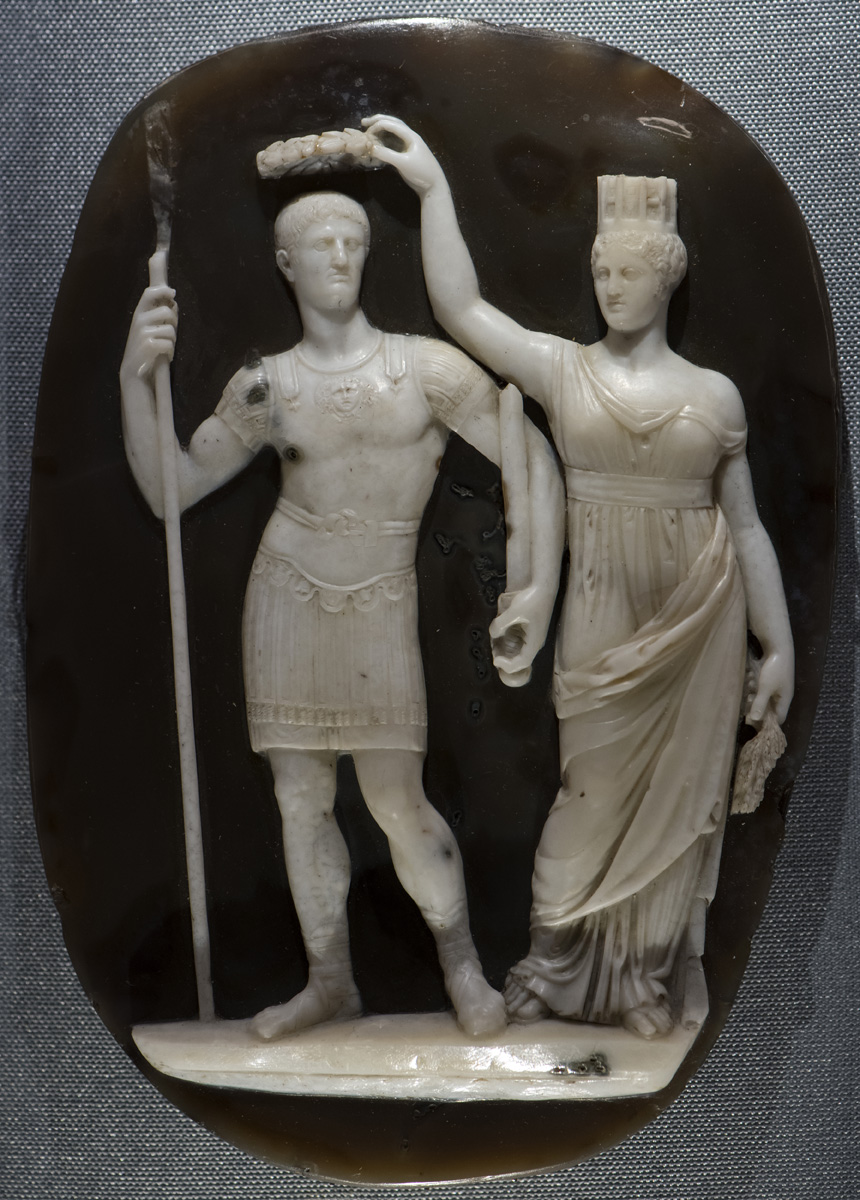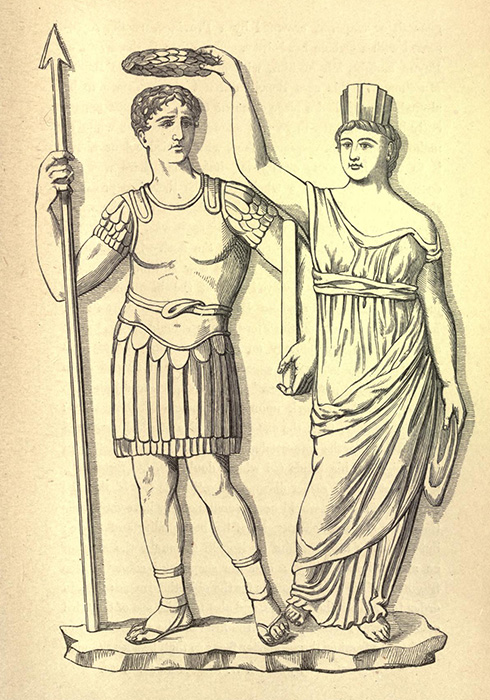
Rome. 4th century.
Reworked in the 19th century by the master Benedetto Pistrucci (1784—1855).
18.5 × 12.2 cm. Inv. Nos. ГР-12534 / Ж 146.Saint Petersburg, State Hermitage MuseumPhoto by Sergey Sosnovskiy
Constantine the Great and Tyche of Constantinople.
Rome. 4th century.
Reworked in the 19th century by the master Benedetto Pistrucci (1784—1855).
18.5 × 12.2 cm.
Saint Petersburg, State Hermitage Museum
(Санкт-Петербург, Государственный Эрмитаж).
—Il trionfo d’ Arianna e Bacco — 8 figure — di forma ovale traversale — 3 pollici
—Flora — frammento — fatto dall’artista per 100 scudi: venduto per 500 sterlini — Sardonica — Museo di Londra.
—Maschera Tragica (altissimo rilievo) fatto per 80 scudi — venduto per 000 sterlini a monsieur Beckford — Sardonica — opera come greca, illustrata da E. Q. Visconti — Museo di Londra.
—Augusto coronato da una Provincia — di forma rotonda — 8 pollici di diametro — Sardonica — opera fatta per 200 scudi, venduta 4,000 creduta Greca anche dal Dennon — Museo di Pietroburgo.
Il Pistrucci co’suoi modelli in cera, co’gessi tratti da cammei, prima di consegnarli, e con certe marche c cifre in luoghi inosservati incise da lui nelle opere sue, rivendicò per sè medesimo, la gloria artistica di averle fatte: cosa che per ignoranza, o per malizia eragli contrastata da chi le vendeva, o comperava come greche.
<…>
Dal necrologio di Benedetto Pistrucci (1856)
Some celebrated engravers—
 |
Curiosità artistiche
Di alcuni piacevoli aneliti avvenuti a Benedetto Pistrucci celebre incisore in cammeo e pietra dura
Singolare intanto fu l’ingegno e la fortuna di questo artista. Mentre dimorava ancora in Italia, e faceva cammei stupendi per isquisitezza di gusto e di valore antico, i mercanti che li compravano a poco prezzo rispetto al merito dell’opera, li rivendevano come opere di maestri già morti
e celebrati quando erano intagliati su pietra di Germania, o come cose di greco artefice quando erano incisi sopra più rara pietra orientale. Onde avvenne talvolta che di possessore in possessore mostrati in ultimo al Pistrucci medesimo, come tesoro acquistato a gran denaro, compiacendosi dello scherzo di che la fortuna gli faceva presente, egli si beffava del lavoro e del maestro che l’avea fatto, (Dio sa con quanto dolore dei nuovi acquirenti), ai quali alla fine palesando l’inganno, sorridendo mostrava ben spesso il suo nome o la sua cifra minutamente grafita in qualche angolo di essi.
Nè è a dire che uomini poco intendenti dell’antico cadessero in tale errore, lo stesso Ennio Quirino Visconti sommo ed oculato ingegno, fondatore dell’ Archeologia, vi diede in isbaglio, lasciandosi portare da poca considerazione quando illustrava dei suoi dotti commenti la Maschera tragica (alto rilievo fatto per ottanta scudi e venduto per novecento sterlini al Signor Beckford) tenuta per greca ed esistente ora nella preziosa raccolta di un privato signore inglese. Nel Museo di Londra pur venne riposta a grande onore la Flora soprannominata, in quello di Vienna il Trionfo di Bacco e Arianna in otto figure sopra sardonica, e in quello di Pietroburgo il famoso cammeo Augusto incoronato da una Provincia, creduto anche dal Dennon di greca mano. Così l’artista romano si godeva vivendo dell’onore che dai posteri vien tributato ai sommi deirantichità.
Pistrucci upon one occasion, while still residing in Rome, had an antique pale-brown sard given him to recut by Domenico Desalief. The subject was a warrior crowned by a female, but so clumsily executed as to be of little value. There was, however, plenty of material to cut away. After taking an impression in wax, he altered the whole; then he cut away the knees of the figures, and recut them higher up, and so remodelled the design that not a trace was left of the original forms. The dealer was delighted, and sold the gem readily for the Imperial Russian Cabinet of St. Petersburg, where it still remains, and is regarded as of the highest value.
See description: Неверов О. Я. Античные камеи в собрании Эрмитажа. Каталог. Искусство, Ленинград, 1988. С. 138—
Text: museum label.
Description (1): Necrologia: Benedetto Pistrucci // Atti della pontificia Accademia di belle arti in Bologna per la distribuzione dei premii, Bologna, 1856, pp. 51—59.
Description (2): Archibald Billing. The science of gems, jewels, coins, and medals, ancient and modern. London, 1867, pp. 83-86.
Description (3): Roma artistica: Pubblicazione mensile, illustrata, diretta dall’arch.to Raffaello Ojetti colla collaborazione di artisti Romani. Vol. 1. Roma, 1872, pp. 22—23.
Description (4): Marsh, J. B. Cameo cutting, London, 1890, pp. 17—18.